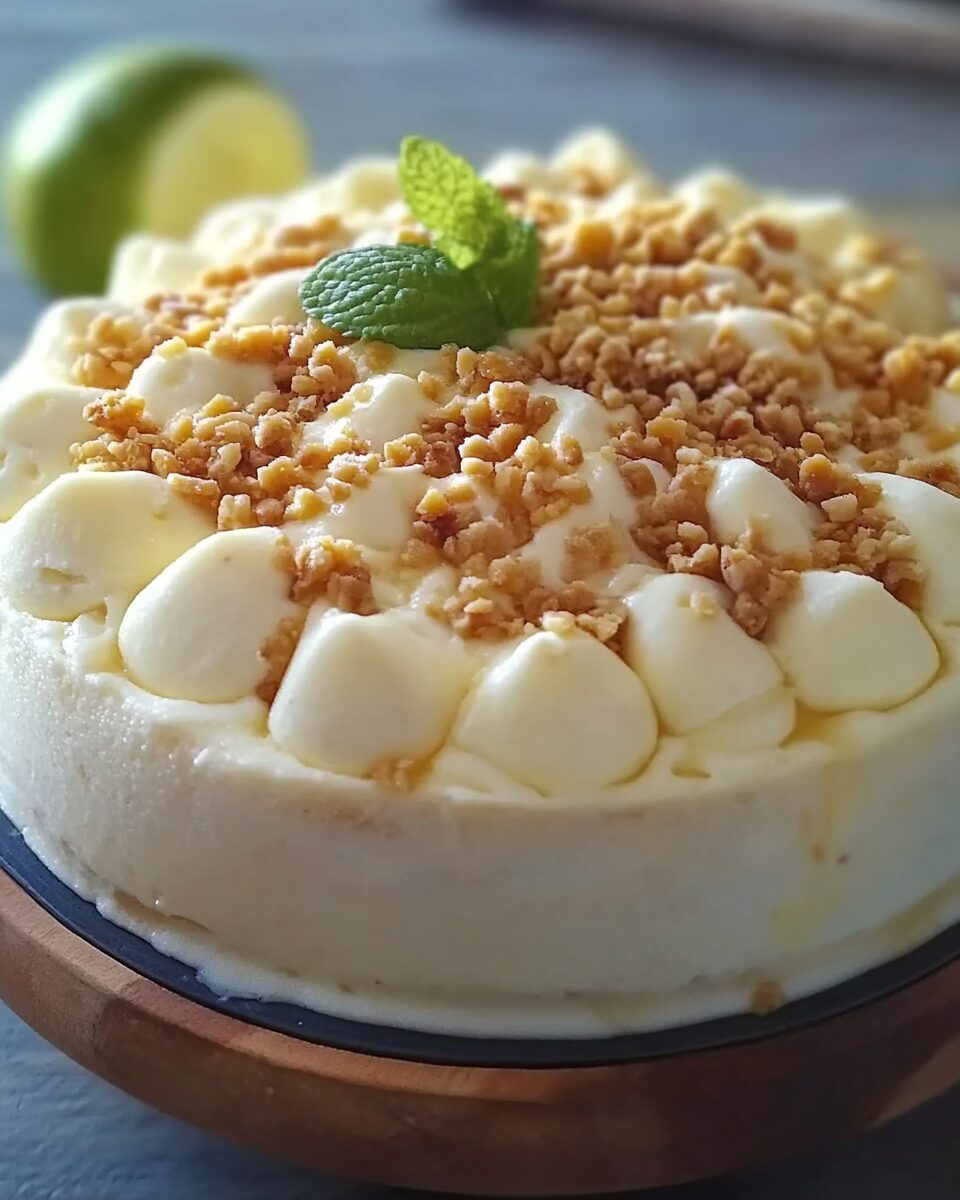Maja Blanca is a beloved Filipino dessert, known for its silky texture and subtle sweetness. Made from coconut milk and enhanced with the natural sweetness of corn, this pudding is set with cornstarch, creating a creamy, spoonable treat that’s wonderfully refreshing. Traditionally topped with latik, or browned coconut cream curds, this dessert offers a delightful contrast of flavors and textures that melt in your mouth.
Perfect for any occasion, Maja Blanca is as delightful to look at as it is to eat. Its rich coconut flavor is balanced by the delicate corn taste, making it both unique and universally appealing. This dish is ideal for cooling down on a hot day or adding a tropical touch to your dessert spread. It’s a simple yet impressive treat that brings a touch of Filipino culture and flavor to your table.
Full Recipe:
For the Latik Topping:
- 1 can full-fat unsweetened coconut milk
For the Pudding:
- 1/2 cup white sugar
- 1/2 cup cornstarch
- 2 cups unsweetened coconut milk
- 1 cup cream-style corn
- 1/2 cup fresh or frozen corn kernels (optional)
Directions:
- Make the Latik: In a saucepan, pour the can of coconut milk and bring to a simmer over medium heat. Stir occasionally, allowing the milk to separate and curdle until browned and crisp. Remove from heat, drain, and set aside.
- Prepare the Pudding: In a separate pot, combine the sugar, cornstarch, unsweetened coconut milk, and cream-style corn. Stir the mixture until the sugar and cornstarch dissolve completely. Add in the optional corn kernels if desired for texture.
- Cook and Assemble: Place the pot over medium heat and cook, stirring constantly, until the mixture thickens to a pudding-like consistency (about 8–10 minutes). Pour the pudding into a parchment-lined dish and smooth the surface. Allow it to cool slightly, then cover and refrigerate for at least 2 hours, or until set.
- Serve: Once set, slice the pudding into squares. Garnish each slice with latik topping before serving.
Prep Time: 10 minutes | Cooking Time: 15 minutes | Total Time: 25 minutes (plus 2 hours cooling)
Kcal: 200 kcal per serving | Servings: 6
Maja Blanca: A Creamy Delight in Filipino Cuisine
Maja Blanca is a beloved dessert in the Philippines, renowned for its creamy, pudding-like texture and subtle, sweet coconut flavor. Known locally as “coconut pudding,” Maja Blanca is a festive treat commonly enjoyed during special occasions and holidays, and it’s often a staple at Filipino gatherings. With its smooth consistency, delicate sweetness, and refreshing flavors, this dessert has won a place in the hearts of Filipinos and anyone who appreciates unique, coconut-based desserts.
Despite its simplicity, Maja Blanca offers a rich culinary experience. Its primary ingredients are coconut milk, cornstarch, and sugar, resulting in a gelatinous, creamy dessert with a mild flavor. Variations often include sweet corn kernels, cream-style corn, and a topping of latik, or browned coconut curds, which adds a delightful crunch to its soft base. Maja Blanca’s appeal extends beyond its flavor; it is a dish that reflects Filipino culture, tradition, and a love for coconut-based foods.
Origins and Historical Roots of Maja Blanca
Maja Blanca has historical roots that trace back to the Spanish colonial era in the Philippines. Its name, which loosely translates to “white delicacy,” suggests Spanish influence, as the word “maja” in Spanish refers to something beautiful or exquisite. Over time, the Filipino adaptation of this dessert evolved, incorporating local ingredients such as coconut milk and corn, which were more readily available than the dairy-based ingredients commonly used in Spanish puddings.
In Spain, similar desserts known as “maja blanca” or variations of “maja” use milk or cream as a base. However, the Filipino adaptation of Maja Blanca became more distinct as it substituted dairy with coconut milk, thus giving the dessert a tropical flavor profile unique to Southeast Asia. The introduction of cornstarch, meanwhile, helped solidify the pudding, giving it the gelatinous texture that distinguishes it from custards or dairy-based puddings.
Cultural Significance of Maja Blanca
Maja Blanca holds a unique place in Filipino culinary tradition. It is a popular dessert, especially during festive occasions like Christmas, New Year, and town fiestas. Known for its crowd-pleasing flavors and ease of preparation, it’s often served in large batches, making it perfect for family gatherings and celebrations. Filipinos of all ages appreciate Maja Blanca for its simplicity and refreshing taste, particularly during the tropical heat.
More than just a dessert, Maja Blanca is also a symbol of Filipino resilience and creativity. The Filipino people have a long history of adapting foreign dishes and making them their own, and Maja Blanca is a prime example. This dish exemplifies the resourcefulness of Filipinos, who have skillfully used local ingredients to transform a foreign dessert into something uniquely Filipino, incorporating flavors that reflect the tropical environment and Filipino agricultural staples.
Textural Experience and Taste Profile
One of the most appealing aspects of Maja Blanca is its texture, which is smooth, soft, and slightly firm. It has a gentle mouthfeel that resembles a soft custard or a pudding but with a more structured consistency due to the cornstarch. The primary flavors are coconut and corn, which complement each other beautifully. The coconut milk provides a creamy, rich foundation, while the corn adds a hint of natural sweetness and a subtle crunch that contrasts with the dessert’s softness.
Some variations of Maja Blanca incorporate latik, a topping made from caramelized coconut cream. This topping adds a delightful texture and a mild, nutty flavor that enhances the overall experience. The latik gives each bite a little bit of crunch, balancing the creaminess of the pudding and providing visual contrast with its light golden-brown hue. It’s no wonder that Maja Blanca is cherished not only for its taste but also for the sensory experience it offers, making it a satisfying dessert on multiple levels.
Variations and Adaptations of Maja Blanca
Though the traditional version of Maja Blanca is made with coconut milk, cornstarch, and sugar, many cooks have created adaptations to cater to personal preferences and regional tastes. Some popular variations include:
- Maja Blanca con Maiz (Maja Blanca with Corn): This version is among the most popular adaptations, as it adds cream-style corn or whole corn kernels to the mixture. The corn contributes a slight sweetness and a unique texture that complements the creamy coconut base, making it a favorite for many.
- Maja Blanca Espesyal: To make Maja Blanca more luxurious, some add heavy cream or evaporated milk to the coconut milk, creating a richer and creamier texture. This version is sometimes topped with grated cheese, offering a salty contrast to the dessert’s sweetness.
- Maja Blanca with Ube (Purple Yam): Some recipes incorporate ube, or purple yam, which gives the dessert a vibrant purple color and a subtle earthiness that complements the coconut flavor. This adaptation is visually striking and has become increasingly popular in recent years, especially among those who appreciate traditional Filipino flavors.
- Buko Pandan Maja Blanca: Another variation combines the flavors of coconut and pandan, an aromatic leaf that imparts a unique flavor and a light green hue. This version is often made with buko (young coconut) for added texture and flavor.
Nutritional Aspects of Maja Blanca
Maja Blanca, while delicious, is best enjoyed in moderation. Its primary ingredients include coconut milk and sugar, which contribute to its caloric content. Coconut milk, a staple in many Southeast Asian cuisines, is rich in saturated fats. However, it also contains medium-chain triglycerides (MCTs), a type of fat that some studies suggest may help with energy production and potentially aid in weight management when consumed in moderation.
Corn, another key ingredient in many Maja Blanca variations, is an excellent source of fiber, vitamins, and minerals, including vitamin C, potassium, and folate. The addition of corn adds a nutritional boost, as well as a slight sweetness, without the need for excessive sugar. Some cooks even substitute a portion of the sugar with a natural sweetener to make the dessert a little lighter.
Serving Suggestions for Maja Blanca
Maja Blanca is traditionally served in square portions, cut into blocks after being chilled and set in a large tray or baking dish. Each square is often topped with latik, which not only adds a visual appeal but also an extra layer of flavor. For special occasions, it may be served on individual plates, garnished with extra coconut flakes or even grated cheese for an added layer of richness.
Since Maja Blanca is a chilled dessert, it’s best served cold, making it ideal for warm weather. It can be a refreshing dessert at the end of a hearty meal or a delightful snack on its own. Some people also enjoy pairing Maja Blanca with other Filipino desserts, such as bibingka (rice cake) or leche flan (custard), during holidays and celebrations, creating a dessert spread that showcases the diversity of Filipino sweets.
Tips for the Perfect Maja Blanca
Achieving the ideal consistency in Maja Blanca can be a bit challenging, especially for first-time makers. Here are some tips to ensure success:
- Mix the Cornstarch Properly: Make sure the cornstarch is fully dissolved in the coconut milk mixture before cooking. This will prevent lumps from forming and help achieve a smooth, creamy texture.
- Stir Constantly: When cooking the pudding, continuous stirring is essential to prevent the mixture from sticking to the bottom of the pot or forming lumps.
- Use Full-Fat Coconut Milk: While you can substitute lighter versions, full-fat coconut milk gives the dessert its characteristic creaminess and richness. The extra fat also helps the pudding set better.
- Chill Completely Before Serving: Allow the Maja Blanca to chill for at least two hours or overnight if possible. This helps the pudding to firm up and makes slicing easier.
- Experiment with Toppings: While latik is the traditional topping, feel free to experiment with alternatives such as toasted coconut flakes, grated cheese, or fresh fruits for a modern twist.
Conclusion: The Allure of Maja Blanca
Maja Blanca has a well-deserved place in Filipino culinary tradition as a dessert that combines tropical flavors with a comfortingly smooth texture. Its adaptability and simplicity make it a popular choice for celebrations and family gatherings, offering a taste of the Philippines with every bite. Maja Blanca exemplifies the creativity of Filipino cuisine, taking simple ingredients like coconut milk, corn, and cornstarch, and transforming them into a delightful dessert that satisfies both the sweet tooth and the desire for a comforting, creamy treat.
Whether you stick to the traditional recipe or experiment with modern twists, Maja Blanca is sure to impress. Its mild sweetness, creamy consistency, and unique toppings make it a dessert worth savoring, inviting everyone to experience a piece of Filipino culture and culinary heritage.

